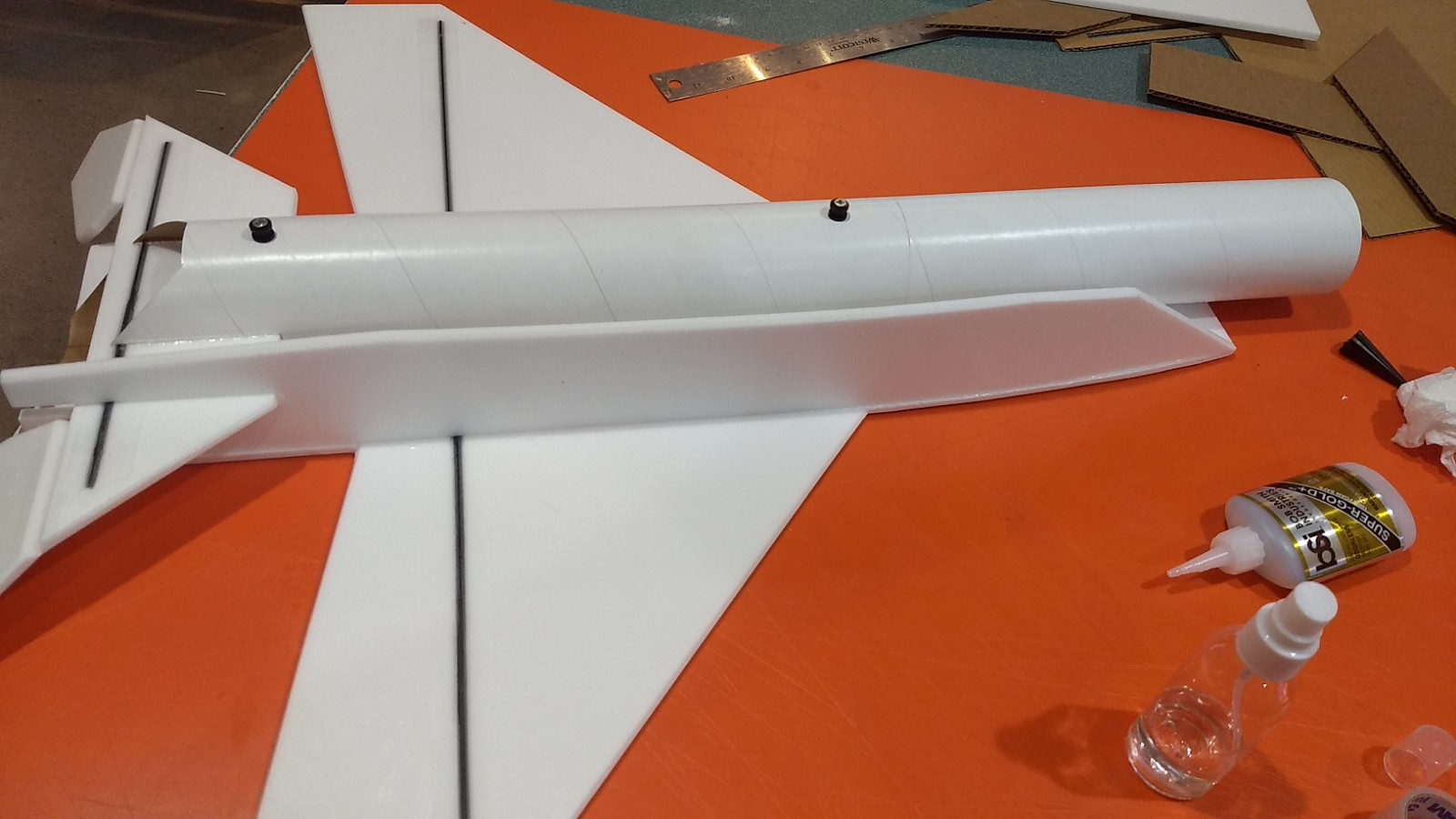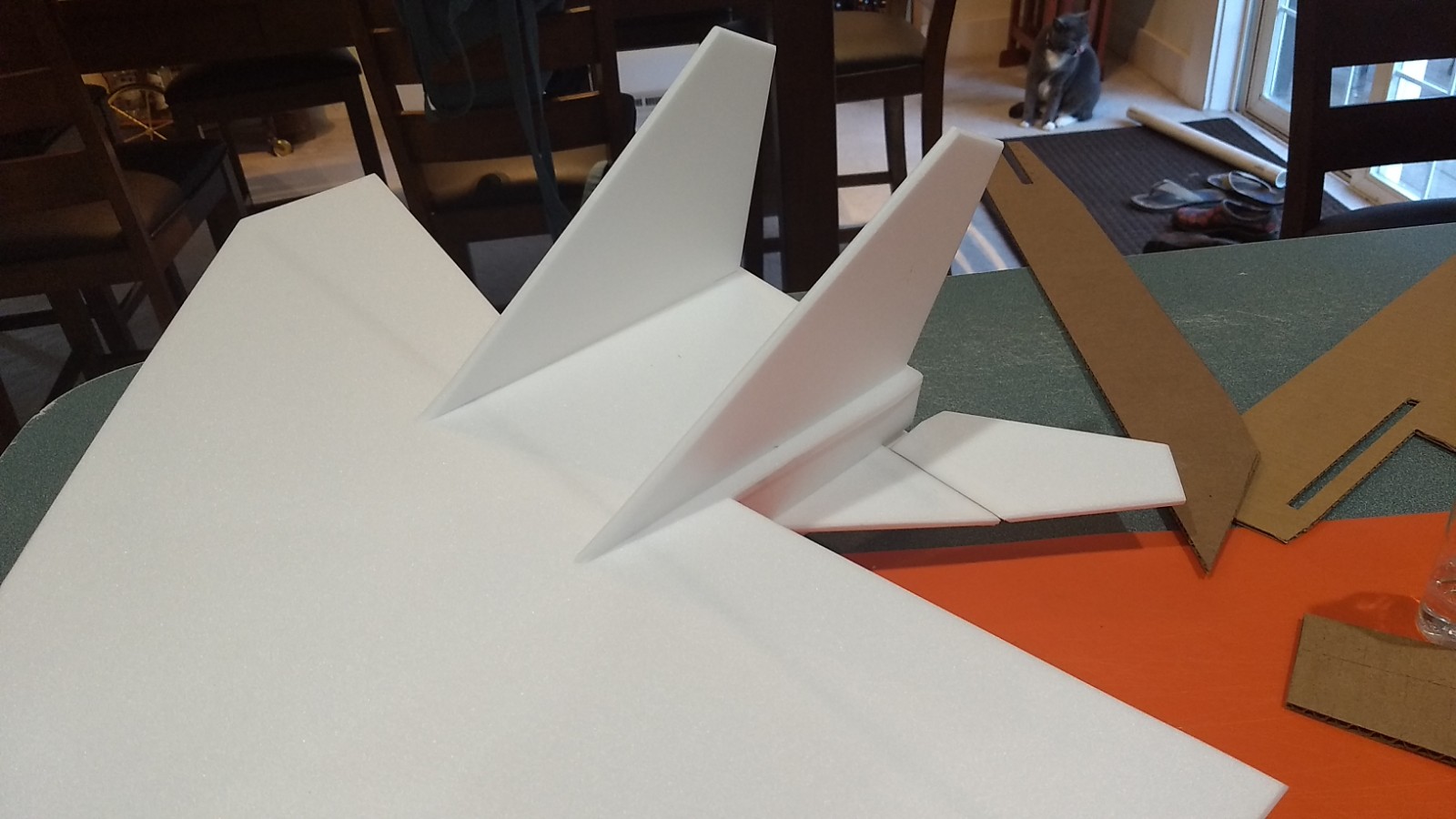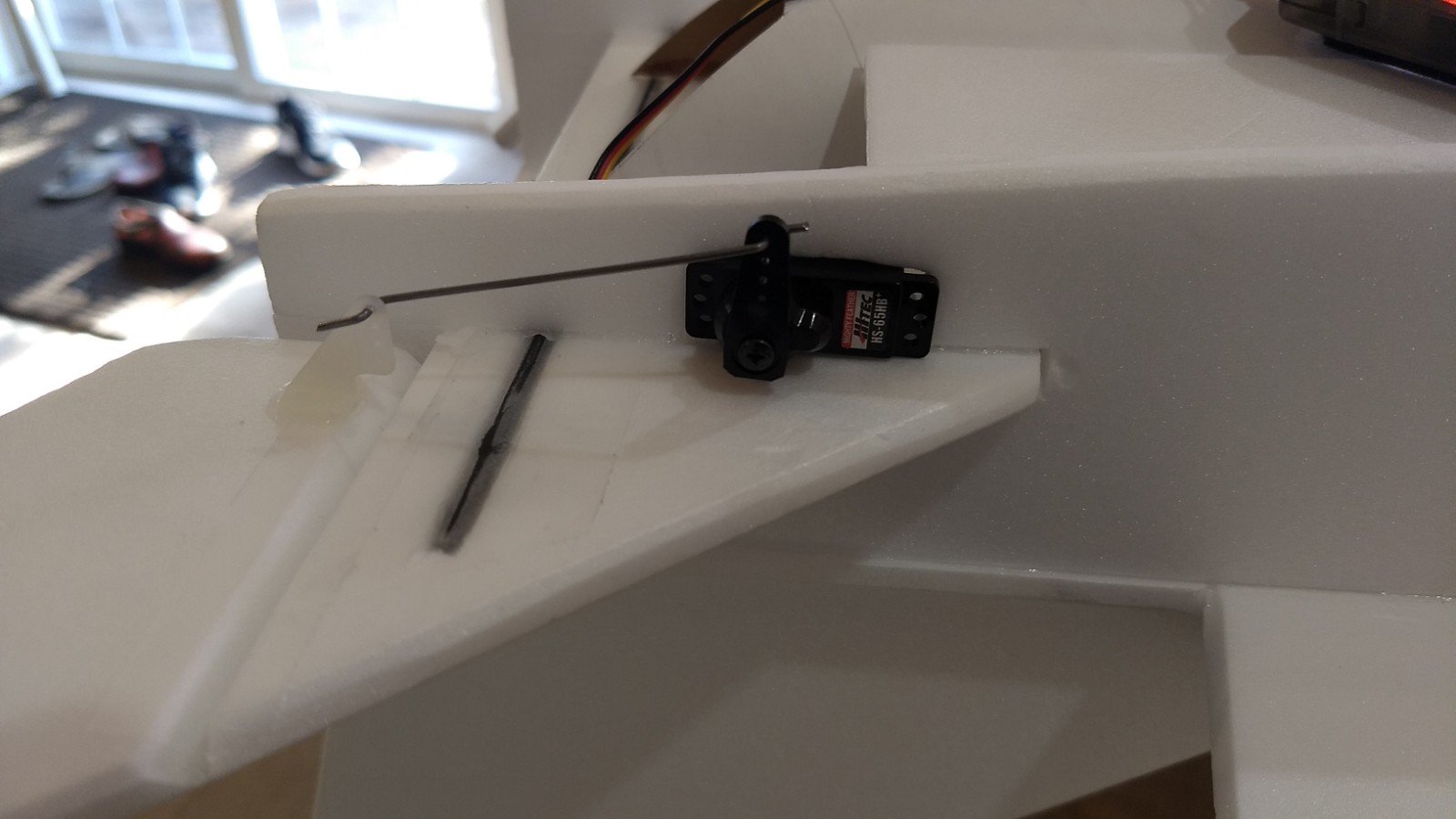
The Mig-25 Foxbat RC Rocket glider kit is based on the famous Russian Mach 3+ Interceptor. It features a high mounted wing with spar pre-installed, a plastic nose cone, 2.6″ white tubing for the body and depron wing and tail surfaces. Elevons are pre-hinged. The body tube end is pre-cut at an angle and the rail buttons holes are are pre-punched. Specs: 37″ length, 23.5″ wingspan, 10.75 oz rtf, for 24mm E-6 single use or reloadable motors.
CG location for rocket flight with battery and loaded motor installed: 12 5/8″ forward of the top rear of the fuselage.
Please refer to the General Information Link above then read the instructions completely before starting assembly. The assembly photos are for general reference but may not include every step in the instructions. If you want hardcopy to work from, all you have to do is click/drag/select and copy all of the text below, open word and paste with “keep original format” and it looks exactly like it does online then you can print it.
If you want to order the decals from sticker shock you can order them HERE
Unpacking your kit:
The kits are packed to protect them in shipping, but the contents are fragile so unpack carefully. Carefully cut the tape holding the tubes in the box, then unwrap/lightly cut the plastic wrap to free the tubes, the spar may be packed in the tubes and the baggie with the little parts and nose cone will be in the tubes as well. Carefully cut the tape holding the cardboard wing protector in the box and carefully remove it, don’t pull hard or bend it. Then carefully cut the tape holding the cardboard top piece to the bottom. There may be some sticky tape holding the cardboard to the bottom cardboard piece, carefully peel it being sure not to bend anything. Once the top cardboard is free you can see the foam wing/tail parts, there are little fragile pieces in here, so unwrap carefully. It may be best to use an exacto to lightly cut the plastic wrap and carefully remove it without cutting into the foam. Make sure everything is free before you remove the pieces to avoid breaking anything. Kits contain one or two scrap pieces for repairs if you damage anything in construction or flight, just cut and patch in a spare piece of the foam if needed using foam safe CA+.
Welcome to the world of rocket boosted radio control gliders. This is not a model for a novice RC pilot, but anyone who is comfortable with RC flying of a medium speed model should be fine. Read through the instructions, look at the photos and be sure you understand the step before commiting to cutting or glue.
Mig-25 Foxbat Rocket glider instructions
Identify all pieces, the kit should contain:
1 wing taped together
1 Nose Cone
Coupler
1 horizontal stabilizer with elevons attached
2 vertical stabilizers
2 control horns w/pushrods
2 2.75″ beveled motor tube supports
2 Body Tubes
Motor mount
Thrust ring
2 engine intake side plates.
2 bottom intake plates.
1 spine tunnel(19 58″ by 9mm)
3 cockpit pieces.
Velcro(for battery and rx/bec attachment)
Lead weight
Spare depron
Notes before starting:
Reference to glue, CA, or CA+ means foam safe CA+, normal CA+ will melt the foam! Normally you need to use accelerator to get the CA to set on the foam since there is nothing for it to soak into and activate.
Instead of sanding, I’ve found I get a nice edge by simply using a thin metal straight edge and cutting a 1/16″ bevel on the edges on the top and bottom, it looks almost as good as sanding, is less messy and less prone to snag and tear a foam edge. If you want or need to sand, use 320 grit paper on a hard block and do small amounts at a time. You can bevel or sand:
- all edges of the vertical stabs except the tab,
- the top edges of the wing and top fuselage profile, and the bottom edges of just the wing.
- All edges of the horizontal stabilizer assembly.
- The bottom outside edge of each side plate, note there will be a left and right so only bevel the outside edge of each at the bottom only.
Epoxy is not needed in this model. Weight is critical and the model is designed for the thrust and flight loads.
Assembly:
- If your kit came with a motor block ring, glue it to the front of the motor tube at this time.
- Install the two rail buttons in their respective holes.
- Join the body tubes using the coupler, note the two tubes have arrow marks, make sure these are aligned as you glue them together.
- Unfold the wing and apply glue to the wing at the taped joint and set it on a flat surface to dry.
- Apply glue the center line of the bottom of the wing and then place the wing on the top of the body tube even with the rear of the body tube and centered on the alignment line drawn on the body tube. Then flip the model over and lay the wing on a flat surface and hold the body tube from moving till it sets, ensure the wing stays aligned and the rail buttons stay vertical.
- Glue the motor tube inside the rear of the body tube while the assembly is upside down, note the rear of the motor mount should be even with the line drawn on the tube about 1″ inset from the end and aligned straight along the body tube axis. Make sure the thrust ring is forward!
- Once the motor mount is set, glue the two short angled foam reinforcing pieces on either side of the motor mount to give it extra mounting strength.
- Insert the horizontal stabilizer assembly into the slot in the rear of the tube, the model is upside down so the spar should be visible. Make sure it is centered left to right by measuring, this needs to be fairly accurately centered. Glue in place when it is correct.
- Carefully remove the foam from the two slots in the rear of the two side plates. Save those for later, they are used to fill in after installing the plates to the rear of the stabilizer.
- Test fit then glue the side plate onto the model. Start at the rear. Make sure the slot is butted against the stabilizer front, and the side leaves enough clearance for the elevon to move, take your time. I inset my side plate about 1/16″ from the edge of the wing top view so I could put a glue joint on the outer and inner surface. Work your way forward, you will have to bend the side plate at the front to conform to the shape of the top view. Repeat for the other side.
- Once set use the spare foam to fill in the slots to the rear of the elevon using the pieces you removed from the side plate.
- Find the two bottom plates, note they have a slight contour near the front, those will go against the side plate and the straight edge will attach to the bottom of the body tube. I glued a little at a time starting from the front and gluing to the side plate on the inside. Once set I glued the plate down to the body tube. Repeat on the other side.
- Glue the two vertical stabilizers in place. The slots are cut at a slight angle so they should angle outward very slightly.
- Glue the three cockpit pieces together, then shape with a sanding block and/or knife. The front tapers to a point and then round the other edges. To make a good glue joint, I wrapped sandpaper around the front of the model and the nose cone and then drug the bottom of the cockpit back and forth till the bottom was rounded and the piece fit against the wing and body tube snugly, the bottom of the front of the cockpit is oversized to allow fitting.
- Glue the cockpit to the front of the body tube and wing on the wing alignment mark.
- Round the top corners of the conduit piece, and round the small rear of the conduit and then make sure the front wide portion lines up well with the rear of the cockpit assembly. Trim/sand to fit then glue to the top of the wing.
- Glue the two control horns into the bottom of the control surfaces, note the pushrod should be closest to the body tube so that the z bend is correct, there is a right and left version, see pictures for clarity.
- Once the glue is set apply glue to the top of the prongs of the control horn to lock it in place.
The basic construction is now complete.
Radio Installation
Note: Your radio needs to be configured for Delta mixing, this means that the servo arms will move the same direction during elevator stick movement and opposite for aileron stick movement. Connect your servos to the receiver one in the aileron connection and one on the elevator connection and apply power. Use a servo arm at least 9/16” long and with holes small enough that there won’t be slop with the pushrod wire when installed. I use the hole furthest out on the servo arm, to maximize movement. On some servos there are a long two-ended servo arm, you can trim off one end if needed to get sufficient length. Zero out any trim settings on the transmitter.
- Connect a servo to each pushrod. If the pushrod is too tight, you can use twist an exacto knife in the servo arm hole to make it larger, but be careful and do not make it too large. Once connected, tape each servo in place near the bottom of the stabilizer temporarily so that the control surfaces are centered. Flip the model right side up and look at it from the rear. Moving the transmitter stick back(up elevator) should move both elevons up. Moving the transmitter stick to the right should move the right elevon up and the left elevon down. If you can’t get the servo reversing to give you the right polarity try swapping aileron/elevator inputs to the receiver or turning the servos over and swapping the servo arms to the other side of the output shaft. If that is correct, continue.
- Attach a servo extension that is 18-24″ long to each servo, long enough to reach to the front of the body tube.
- Flip the model upside down and supported. Mark where each servo would go to have the control surface centered, then cut a rectangle into side plate so it will fit. You’ll need to route the servo wire through the hole and re-attach it to the receiver at the front of the model.
- Route the servo wire into the hole and route through the rear of rhe body tube and forward. Connect to the receiver. With the radio still on and receiver powered up, glue the servo in place being careful not to get any glue near the output shaft. Keep the elevon surface level as you do this. Adjust the servo position or foam so the surface is flat then apply glue to the servo and foam to hold it in place. Do the same to the other side. Make sure the glue is set before continuing. See pictures for help.
- Flip the model back right side up. Make sure the control surfaces are centered, use trims if needed. Now measure the control surface movement. Full elevator movement should be 1” in each direction, aileron movement should be 1″ in either direction. Since the model will be nose heavy, extra elevon movement helps to give sufficient authority during glide.
- If you have a flap/elevator mix you can program up elevator to a switch setting. The model needs approximately 1/2″ of up elevon during glide. If you can’t set the up elevator trim to a switch on your radio you’ll have to manually put in boost and glide trim which is hard to do while flying the model. My model required about 5/16″-3/8″ of downtrim for a straight boost.
- Attach the receiver inside the front of the body tube, about 2″ back at the top with the provided velcro.
- Attach the flight battery into the nose cone with the rest of the provided velcro.
- Finish the model as desired, see general instructions for paint recommendations and warnings. I did not paint mine to keep it light. I used a sharpie pen and clear drawing triangles to make panel lines using the guide and it adds a lot to the model and doesn’t take that long. If you purchase the sticker shock decals refer to the pictures for placement. After application of the vinyl use a hot hair dryer to soften decals and press them in with your thumb to make them set and conform to the model.
- Balance the model after painting.
- Insert your heaviest loaded rocket motor into the motor mount and install the flight battery as if you were going to fly it.
- Support the model right side up at the balance point indicated for boost. Glue pieces of the included lead weight in the nose or tail as needed to balance it. Do not try to fly the model with it balancing it behind this point or significantly nose heavy. The adage is, a nose heavy model flies poorly, a tail heavy model flies once.
Flying: See the General Information link at the top for flying instructions. Be ready on the first few flights to keep the model straight till you have the trims set perfectly for boost and glide.
- Completed Model
- Install the front rail button
- Install the rear rail button
- Join the two tubes with the coupler keeping the alignment arrows aligned.
- glue the taped joint on the wing then lay flat to dry
- Glue the wing to the body tube with the rear of the wing even with the rear of the top of the body tube and aligned with the body tube mark, then flip over and make sure it dries centered.
- Glue the motor tube using the mark for alignment, it will be inset 1″ from the end.
- Glue the two reinforcing strips on either side of the motor tube.
- Insert the horizontal stab unit, make sure it is centered and then glue in place.
- Glue the side plates in place, make sure the rear does not interfere with the moving elevon portion as you glue.
- Glue the side plate as you go keeping it about 1/16″ in from the outer edge and conforming to the shape of the wing and top view.
- Front showing how the side plate angles in to match the curve of the top plate.
- Glue one of the bottom plates in place, note how the front starts at the lower intake bevel and how I’ve beveled that piece. Note the pieces are cut with a radius to match the curve, make sure you are installing it correctly.
- Continue gluing all the way back
- When done glue the bottom plate to the body tube.
- Use the piece of material you removed from the side plate slot and trim a piece to fill in the gap behind the stabilizer.
- Install the two vertical stabs. I try to cut them at a slight angle, they angle out just slightly.
- Glue the cockpit together and sand to shape
- Glue the cockpit to the front of the body tube and wing
- Sand round the top of the conduit piece then glue to the top of the model butting against the cockpit piece you glued earlier.
- Install a pushrod/horn in each elevon on the bottom, note the pushrod is on the inside of the horn so that the z bend is closest to the servo, do the same on the left side.
- Airframe completed.
- Fit the servo and mark where the cutout will be for the servo, then cut it out, remove any glue from the bottom.
- Glue the servo in place in the slot keeping the elevon level
- Elevons hooked up, servos installed, and connected to the receiver.
- Route the receiver out to the front of the model from the back and hold in place with velcro at the top of the tube. The battery can be located inside the body tube as well or inside the nose cone as needed to make CG.
- Top view showing panel lines.
- Side view.
- View showing stickershock decals.
- Rear view.






























